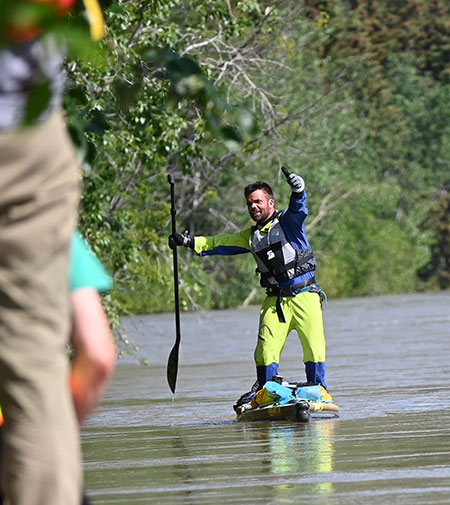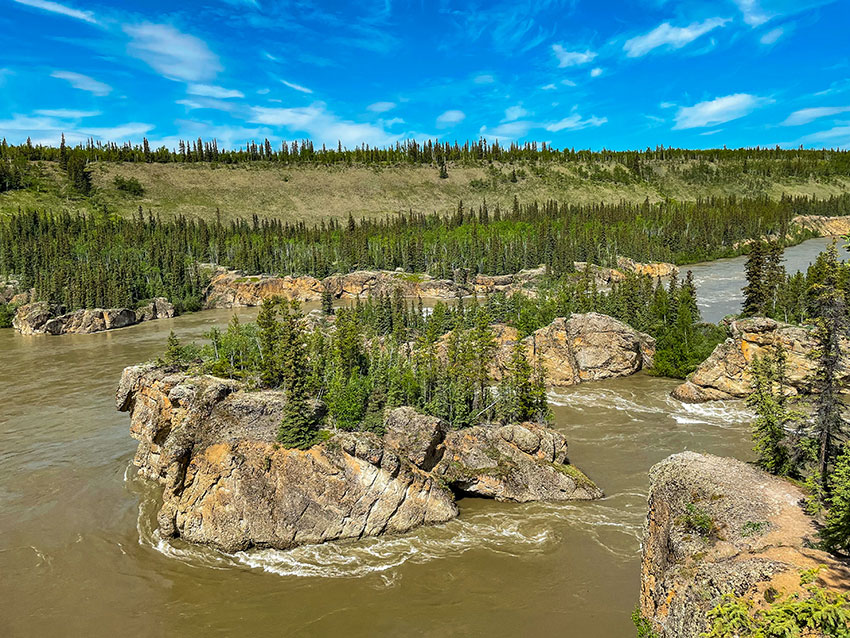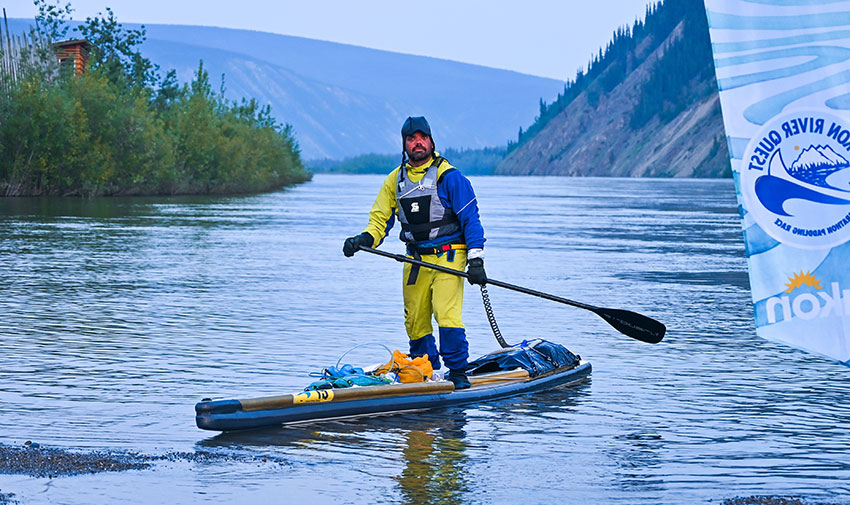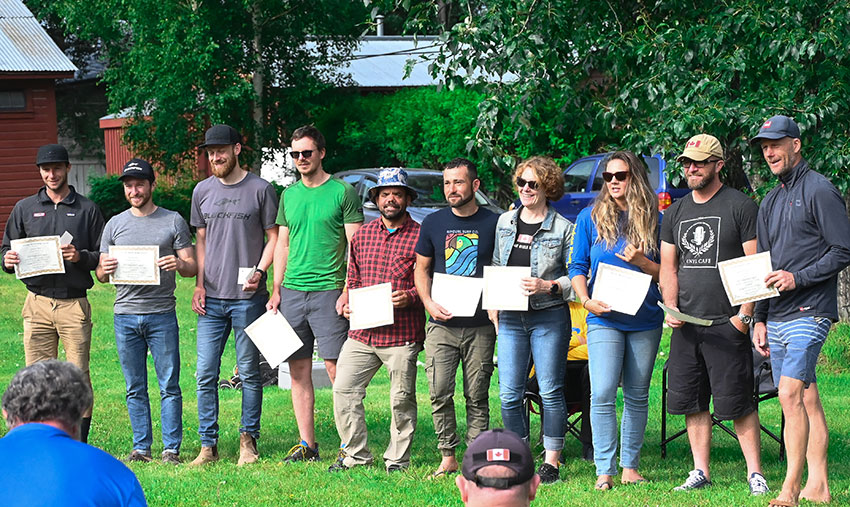Shortly before the end of the lake, the wind shifts and the waves come from behind. Maybe it’s me or the SUP, but these waves from behind don’t suit me at all. Some other stand up paddlers would be happy about a downwind session. I really struggle with it and lose the connection in the last 2 km and paddle alone to the checkpoint at the end of the lake.
I go ashore where I am immediately greeted by a husky and thousands of mosquitoes fall on me. But walking a few steps feels really good now. It is already after 8 pm and time to prepare for the night. I put on an extra thermal layer under the dry suit, pack new food rations from my dry bags onto the SUP, refill water and fortify it with plenty of caffeine. I don’t stay too long, although there is a campfire and hot water for tea. But the mosquitoes drive me away and I am aware that time goes on without me here.
Then finally on the river again. It feels like being on a motorway and the landscape passes by quickly. – Almost too fast. Because the section of the 30-Mile River is one of the most beautiful on the whole trip. I look around, enjoy the scenery and search the banks for bears and other animals, but am abruptly interrupted when an eddy almost pulls the board out from under my feet. I almost fell into the water, which is why I decide to pay more attention to the flooded river from now on.
Soon I pass the spot at Hootalinqua where the remains of the paddle steamer Evelyn lie on an island. An old shipwreck from the gold mining days around 1900. The more or less intact wooden remains can still be visited, but unfortunately there is no time for that. I catch a glimpse of it when I cautiously look to the left. – Hopefully I will have more time on my next visit.
In the meantime, the muscle pain I had towards the end of the lake has gone. – As expected, my body got used to it after a good 20 hours of paddling.
The narrow section of the river allows speeds of up to 19kmh and I arrive at the first mandatory stop in Carmacks earlier than expected. It’s not easy to hold on to the jetty in this strong current. But with the help of the supporters it works.

I have calculated three hours here. Change – shower – protein shake – massage – 1h sleep – pasta breakfast – continue. That was the plan and the instructions to my support team. But after breakfast I decide to rest for another hour, because I am too tired and there is a rain front moving across the camp. Besides, I have more than 2 hours head start on the SUP behind me.
Well rested, I get back on the SUP after 4 hours. Now comes the exciting section. The river still pulls very strongly. And the infamous Five Finger Rapids are coming up. Rapids that are no problem at normal water levels. But at high water and with a 14’x26″ race inflatable they can be tricky. On a normal river adventure, falling into the water wouldn’t be a big deal, but during the race I’d rather avoid falling in.
Then I can hear it, the roaring and raging of these rapids. Now it is essential that I choose the rightmost of the three rock gates. I try to stay as central as possible in the right rock gate, as I had planned when scouting on the rock. I glance to the left to make sure that there is no large drifting debris in the middle channel, as this could hit me in the middle of the rapids. Now everything happens in a flash, I pass the gate of the rapids and have only one thing on my mind: stay in the middle and just make sure that the SUP doesn’t come anywhere near crosswise, otherwise it will pull me right against the rocks or left into the whirlpool. – Pull hard and aim for the tip of the V-shaped current. But the waves are higher than expected. Almost 2m between the wave crest and trough. Waves of water overflow my SUP. – Hopefully my luggage will hold.
After a few seconds, the spook is over and I already have to make sure that I take the right path between the islands, because the river is still moving very fast. So fast that I should reach the second compulsory stop in Minto after only six hours.
But suddenly I hear thunder and see lightning in front of me. Right in the direction of Minto, but fortunately still far away.
Only one hour left until the well-deserved last mandatory stop. And now there are thunderstorms coming up on my left and right. And yet I am so close to the stage finish. The thunderstorms still seem to be some distance away, but I decide to paddle on, kneeling close to the shore.
Immer mit dem Spruch eines Kajakers im Hinterkopf “Bei dir sind wir bei Gewitter sicher, du bist der höchste Punkt um uns herum :-)”
Then heavy rain showers set in. Luckily I have a dry suit and a neoprene cap to protect me from the cold, because with the rain the temperature drops by 10 to 15 degrees Celsius.
Around 10pm I finally reach Minto. Perfect timing, which will also support my sleep rhythm. Again, the same game. Eat – sleep – eat. I even allow myself a few extra minutes, don’t stress myself to keep the 10 hours minimum rest time. Anything over that counts as paddling time.

When I get on the SUP in Minto at 4:30, there is thick fog over the river. There is practically nothing to see. Not an island, not a hill, not even the next river bend. Every paddler is obliged to carry the legendary “Rourke map”. – A detailed, hand-drawn map showing the entire Yukon River with all its bends, islands and side channels. The rock faces and hills on the shore serve as orientation, but there is absolutely nothing of that to be seen at the moment. Fortunately, I took the time in advance and saved the entire route in my GPS watch. This now pays off and so I don’t paddle into the last stage completely blind.
After a while the fog lifts and the Yukon reveals its huge labyrinth of islands over a width of almost 800m. I have fun competing with another participant in navigation. There are so many things to consider. Should I stay in the main current and sail a wider radius? Or cut the bend to save a few hundred metres? Is it worth changing sides of the river to avoid a bit of a headwind? With such an immensely wide river, these are very important decisions. One time I catch the faster route, another time the kayak next door is faster. Reading the map and the current requires a good eye and intuition, but it also provides me with a very high entertainment value.
After about 580km, I finally reach the confluence with the White River. As this river carries volcanic ash, I fill up my drink reserves one last time. In general, the water in the Yukon River is drinkable, but it is advisable to add sterilisation tablets to the water. Any problems, however, would only become noticeable about 4 days later, i.e. after the end of the race.
Now the river becomes even wider, and also slower again. The last night dawns. At sunset at 01:00 I dare to take a shortcut away from the main stream, which saves me 1-2km. I am worried that this part of the river is not blocked, but already at the entrance this supposedly small tributary turns out to be quite wide and passable. The sun is extremely low in the sky and flickers through the bare conifers. At some point the sky turns red and I paddle directly into the sunset… or sunrise? – Because already at 03:00 the sun comes out again. A truly magical moment. But still, the last 40km prove to be particularly hard and exhausting. I struggle with fatigue. I have been on the road for over 60 hours and have only slept 6 hours. But there are “only” 40km to go.
Then finally the long-awaited, striking mountain range towering over Dawson City comes into view. I just enjoy the last few minutes. Knowing that I will reach my destination safely after months of training and hours of paddling makes me happy and wistful at the same time.
In the end, it was enough for fourth place in the SUP category in which 17 paddlers took part. – If there was a separate inflatable category, I would even have won a new all-time best.
CONCLUSION
So many people ask me what the attraction is of such a thing and what I do all the time during the race.
Well, the biggest attraction for me is the Yukon River with its history. Thousands of adventurers took this route in 1896 when gold was found on the Klondike. From Skagway, they walked over the almost 900m high White Pass where the adventurers built boats at Lake Bennett throughout the winter to reach Dawson City via Whitehorse when the ice broke up. Even then it was a race. – Because everyone wanted to get the gold in Dawson City as quickly as possible.
I have also been fascinated by the stories of Jack London for a long time, and so I was drawn to this river as one of the first ever stand-up paddlers back in 2014. Two years later, I was on the Yukon River again and learned that SUPs were now allowed in this legendary race. – “No way!” I said to myself. You have to be crazy to do that. – On the one hand the performance, but on the other hand it’s a shame to paddle through such a beautiful landscape in a rush. What the usual adventurer plans a week or two for, I’m supposed to rush through in 70 hours?
When I shot a documentary about stand up paddlers Bart de Zwart and Alex de Sain on the Yukon River Quest in 2018, the fever really got to me.
A year later, the decision was made that I would take part in the 2020 race.
For me, however, it was clear from the beginning that I wanted to enjoy this race and not constantly drive at the limit. So hard endurance training was the order of the day.
As we all know, the years 2020 and 2021 were not exactly characterised by travel fever and so the Yukon River Quest was also postponed or cancelled twice.
In these two years I learned a lot about ultra-long distance paddling and also overcame my “magic” limit. As I trained longer and longer distances, I noticed that I didn’t get much more tired after about 40km. So it no longer mattered whether I paddled 40, 60 or 80km. As long as I eat and drink enough and have enough time, such distances are possible without any problems.
But what do you do on the river for 60 hours all the time?
At the beginning of the race, you quickly find a paddling and conversation partner, but the further you paddle, the lonelier you are on the way. You can entertain yourself with some music and enjoy the landscape. For me, a lot of the entertainment was reading the river and the map. There are so many bends, islands and other factors to consider.
Admittedly, you have to be able to cope with being alone for such a long time. If you can’t, sooner or later you get hallucinations. – Many participants report this. Stories circulate that paddlers felt attacked by their gummy bears, saw Indian chiefs, paddled in circles or even against the current.
Will I ever do it again? – Absolutely!
On www.yukon-sup.com you can find more info’s on the race and results



